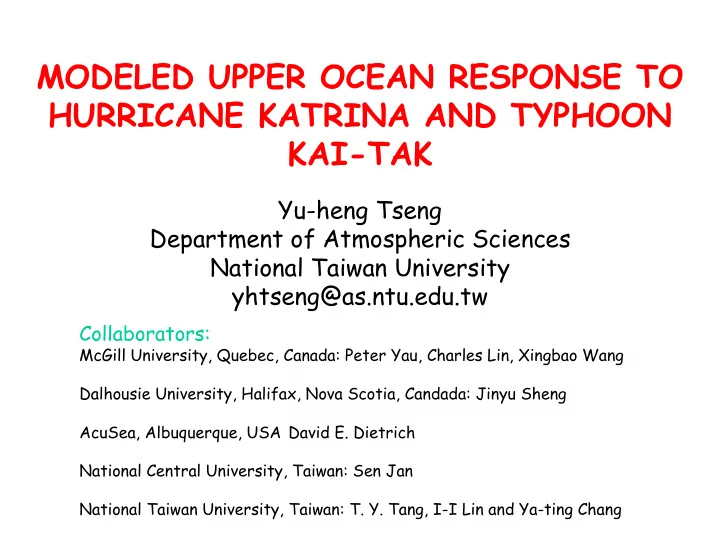

MODELED UPPER OCEAN RESPONSE TO HURRICANE KATRINA AND TYPHOON KAI-TAK Yu-heng Tseng Department of Atmospheric Sciences National Taiwan University yhtseng@as.ntu.edu.tw Collaborators: McGill University, Quebec, Canada: Peter Yau, Charles Lin, Xingbao Wang Dalhousie University, Halifax, Nova Scotia, Candada: Jinyu Sheng AcuSea, Albuquerque, USA David E. Dietrich National Central University, Taiwan: Sen Jan National Taiwan University, Taiwan: T. Y. Tang, I-I Lin and Ya-ting Chang
Contents • Introduction • Model description • Storm induced circulation in the Gulf of Mexico during Hurricane Katrina • Storm induced circulation in the South China Sea during Typhoon Kai-tak (validation) • Summary and conclusion
Observed Sea Surface Height during Katrina
GOM Loop Current Warm eddy enhances the development of Katrina
Animation
MEDiNA model: Bathymetry (km) and sub-domains Six domain: GOM (1/8 o ) 304x336 Greenland NAB (1/4 o ) 162x398 IBE (1/8 o ) 100x794 1/8 o x1/8 o VIS (1/16 o ) 60x158 GIB (1/24 o ) 125x107 1/16 o x1/16 o MED (1/8 o ) 316x157 30 vertical layers; 1/4 o x1/4 o 1/8 o x1/8 o top layer 11 m thick; 1/8 o x1/8 o bottom layer 750 m thick 1/24 o x1/24 o Dietrich et al. (2008)
Initialization • The "initial conditions" (before Katrina winds are applied) are derived from the MEDiNA model using annual cycle climatological wind forcing. • Surface heat and freshwater fluxes are derived from a non-damping, zero-phase-lag approach that supercedes conventional Haney restoring. • During model years 15 and 24, the Gulf of Mexico Loop Current is extended far northward into the Gulf of Mexico during August in those two model climatological years. Such deep penetration during August occurs about one year out of ten as expected. • Both times, the Loop Current flow is similar to the conditions before Katrina. However, the SST is about 2 ° C cooler than the observed extremely warm conditions just before Katrina. • To get better initial SST conditions, satellite observed temperature is assimilated for 30 days just before Katrina using a simple projection method to get a more realistic surface mixed layer.
Bathymetry zoom to Gulf of Mexico
Surface layer vorticity and velocity (animation with 2 hour interval between frames)
Bottom T change Upwelling and cooling
Vertical-longitudinal (zonal) section
REMARKS • The fully coupled MEDINA model is used to simulate the response to Hurricane Katrina winds derived from an MM5 based hurricane model. • An energetic mesoscale eddy with current speeds larger than 4 m/s and horizontal scale 50-100km. Buoyancy and strong wind forcing appear to play a big role in energizing such an energetic eddy. • Strong surface and bottom cooling is found resulting from the vertical mixing and topographical upwelling. • Strong inertial oscillation is also induced. • big problem! No detailed observation for comparison. Only NDBC buoy 42001, 42003, 42040 (information mostly related to waves)
NEED VALIDATIONS Category Mph (m/s) • Hurricane Katrina 1 74-95 (33-42) 2 96-110 (43-49) – Cat. 5 3 111-130 (50-58) – Most destructive 4 131-155 (59-69) 5 156 (70)> • Typhoon Kai-Tak – Cat. 2 – Most significant SST drop (8 ° C> ) – Question: why the SST drops so significant?
Paradise of physical oceanography Complicated circulation patterns in the East Asian seas Extension ” r e d Monsoon n a e M “ Changjiang diluted water CCC “branching” o i h s o r u s n o o K h p y T e l a c s - o “Intrusion” s e M s e i d d e
Seasonal variation of Kuroshio intrusion through the Luzon Strait (Centurioni et al., 2004)
New Evidence for Enhanced Ocean Primary Production Triggered by Tropical Cyclone (Lin et al., 2003c; GRL)
1. Entrianment Depth (PWP model, Price et al., 86) : 90m 2. Uh < 4m/s, Upwelling: 20 * 10 -4 m/s (100m for half inertial period)
Duo Grid Pacific Ocean Model (DUPOM) Kuroshio Extension o Izu Ridge i h s Ryukyu Island Chain ECS o r u k Taiwan Strait North Equatorial Current Luzon Strait SCS
Surface pressure and velocity vectors
Modeled SSTs on different days Along latitude 20.5 ° N KA1 ST Along longitude 119 ° E
Comparisons with observation (station: ST) Sensitivity of turbulent parameterization Temperature drops due to vertical mixing and topographical upwelling Sensitivity of wind stress strength
Comparisons with observation (station: KA1) Vertical mixing matters Inertial oscillations (~32hr)
Bottom current vectors Strong currents along topography
Daily-averaged vertical velocity Day 1 (7/4)
Daily-averaged vertical velocity Day 2 (7/5)
Daily-averaged vertical velocity Day 3 (7/6) Strong upwelling
Daily-averaged vertical velocity Day 4 (7/7)
Daily-averaged vertical velocity Day 5 (7/8)
Daily-averaged vertical velocity Day 6 (7/9)
Summary and conclusion • Strong inertial motions (oscillations) due to hurricanes/typhoons. Impacts on the climate system? • Cold wake (compare well with the observed SST change) • SST cooling biases-vertical mixing, Ekman pumping, vertical convection and others? • Storm induced currents • Strong surface and bottom cooling due to the vertical mixing and topographical upwelling • Better vertical mixing schemes for hurricanes/typhoons? Better surface forcing parameterization/mechanisms (breaking waves)?
Recommend
More recommend